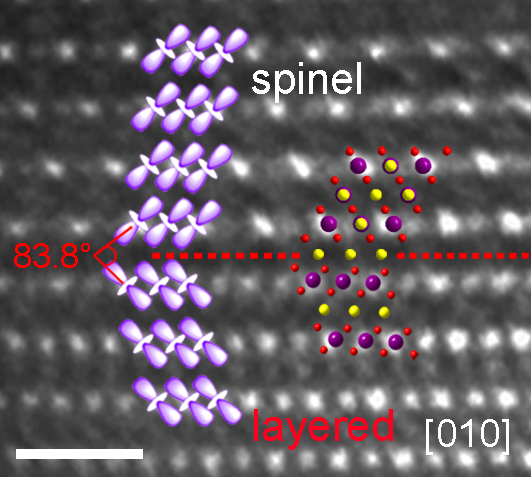Technology breakthrough: doubling the charging-recharging cycle of lithium batteries
The promotion of electric cars has dramatically increased the demand for lithium-ion batteries. However, cobalt and nickel, the main cathode materials for the batteries, are not abundant. If the consumption continues, it will inevitably elevate the costs in the long run, so scientists have been actively developing alternative materials. A joint research team co-led by a scientist from City University of Hong Kong (CityU) has developed a much more stable, manganese-based cathode material. The new material has higher capacity and is more durable than the existing cobalt and nickel cathode materials - 90% of capacity is retained even when the number of charging-recharging cycles doubled. Their findings shed lights on developing low cost and high efficiency manganese-based cathode materials for lithium-ion batteries.
The research team was co-led by Dr Liu Qi, Assistant Professor in the Department of Physics (PHY) at CityU, together with scientists from Nanjing University of Science and Technology (NUST), and the Institute of Physics, Chinese Academy of Sciences (IOPCAS). Their findings have been published in the scientific journal Nature Sustainability, titled “LiMnO2 cathode stabilized by interfacial orbital ordering for sustainable lithium-ion batteries”.
Technology bottleneck of manganese-based cathode materials: low capacity retention
Lithium-ion batteries are now widely used in cell phones and electric cars. Most of the cathode materials contain cobalt and nickel, which are both not abundant and create pollution to the environment in the exploitation process. Therefore, scientists are searching for alternative cathode materials, for example, manganese (Mn).
Among the leading manganese-based candidates, LiMnO2 is cost-effective, more environmentally friendly with larger theoretical capacity. However, it suffers from poor stability during the charging-recharging cycle. Breaking of grains, rapid structural degradation and serious dissolution of manganese may happen. Severe capacity decay upon cycling is resulted and therefore shortens its durability, hindering the application of LiMnO2 in the commercialised lithium-ion batteries.
Jahn-Teller distortion needs to be suppressed
Dr Liu, an expert in developing cathode materials for lithium-ion batteries, pointed out that the structural instability of manganese-based materials is mainly caused by the Jahn-Teller distortion in their atomic structure. Upon discharging, the Mn-O bond in LiMnO2 will be elongated, which is called Jahn-Teller distortion. Since there is a long-range collinear orbital ordering of the electron orbits of the Mn3+ ions without disturbance, a strong cooperative Jahn–Teller distortion is resulted. Their atomic structures are easily distorted.
Dr Liu and his team tackled the problem by applying interfacial engineering in the atomic structure, which disturbs the long-range collinear orbital ordering and suppresses a large scale of Jahn–Teller distortion.


Structural stability enhanced by interfacial engineering
The team prepared the spinel–layered (heterostructured) LiMnO2 via in situ electrochemical conversion from spinel Mn3O4 nanowall arrays. It is found that the electron orbits are oriented almost perpendicular to each other between the spinel and layered boundaries, resulted in the interfacial orbital ordering. “This has caused a disturbance of the long-range collinear orbital ordering, therefore Jahn–Teller distortion is suppressed,” explained Dr Liu.
Their experiment results showed that Jahn–Teller distortion was effectively suppressed with this heterostructure design. The degrees of distortion of the layered and spinel phase was only 2.5% and 5.5% respectively, while layered LiMnO2 and spinel LiMnO2 showed much greater degrees of distortion of 18% and 16% respectively. This implies that the heterostructured LiMnO2 exhibited much higher structural stability. The team also found that the volume changes from the spinel and layered phases counteract with each other, leading to a minimal total volume change for the material. As a result, the material exhibited superior structural stability.
Long cycle life
“The capacity of the LiCoO2 cathode material currently applied in electronic products like smartphones is about 165mAh/g, while our LiMnO2 cathode material has already achieved a capacity as high as 254.3 mAh g?1, which is much higher,” Dr Liu elaborated. “It is difficult for commercial LiCoO2 to maintain 90% capacity even at 1,000 cycles. And our material has achieved high capacity retention of 90.4% after 2,000 cycles, demonstrating a long cycle life,” he added.
They are the first team to deploy interfacial orbital ordering to suppress the Jahn–Teller distortion. This novel method facilitated the development of sustainable Mn-rich cathode materials, in the hope of applying them in sustainable and commercialised energy storage devices. “We look forward to cost reduction in energy storage technology which can promote the energy structure in moving towards sustainability. Our material can potentially replace the currently commercialised cobalt materials for applications such as electronics and electric cars,” concluded Dr Liu.
Dr Liu, Dr Gu Lin, the researcher from IOPCAS, and Professor Xia Hui from NUST are the corresponding authors of the paper. The co-first authors are postdoc Zhu Xiaohui from NUST, Dr Meng Fanqi and Dr Zhang Qinghua from IOPCAS. Other team members included Dr Zhu He, Postdoctoral Fellow from PHY at CityU, as well as collaborating researchers come from NUST, Sun Yat-Sen University, and Argonne National Laboratory, USA.

The study received funding support from including the National Natural Science Foundation of China, the National Key R&D Program of China, the Fundamental Research Funds for the Central Universities, Chinese Academy of Sciences and Shenzhen Science and Technology Innovation Commission under the grant Shenzhen-Hong Kong Innovation Circle Category D Project.
DOI number: 10.1038/s41893-020-00660-9
Newsletter Subscription: Research
Areas of Interest